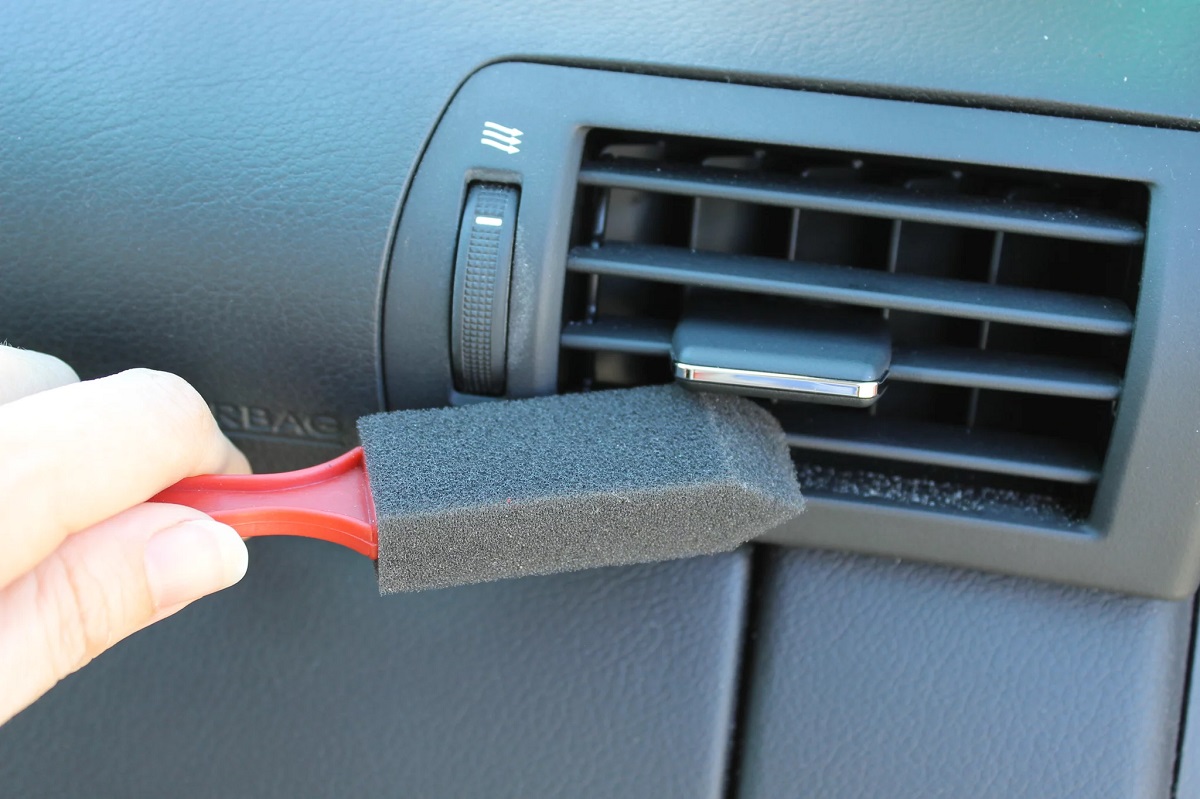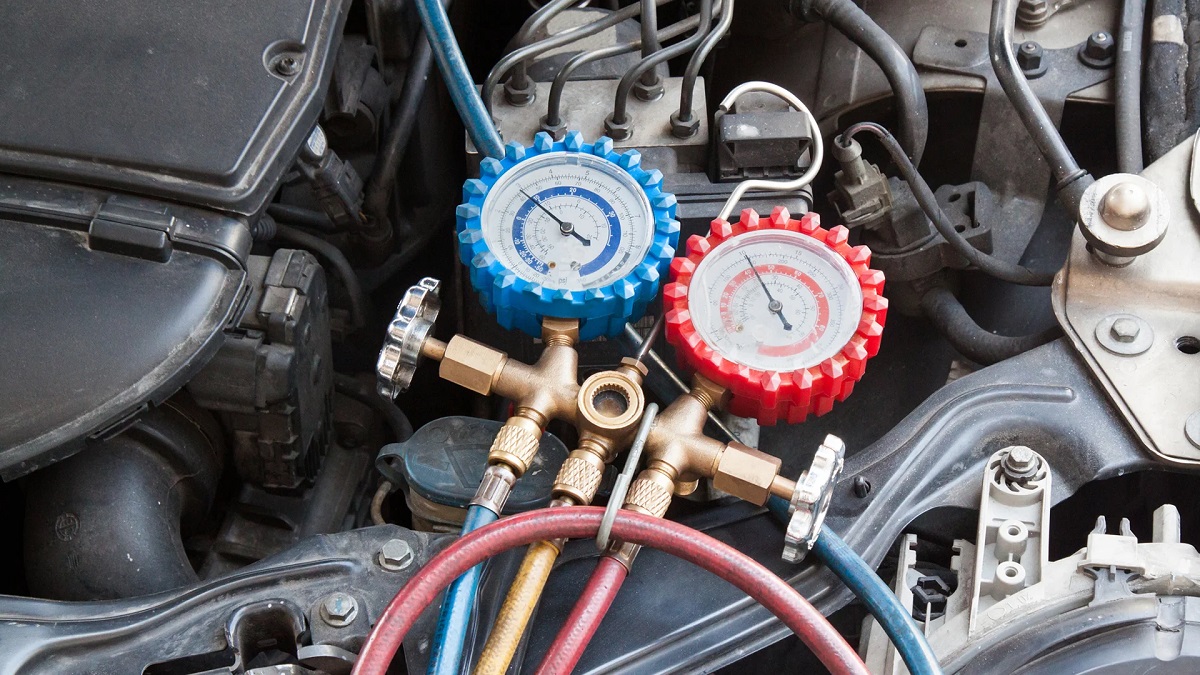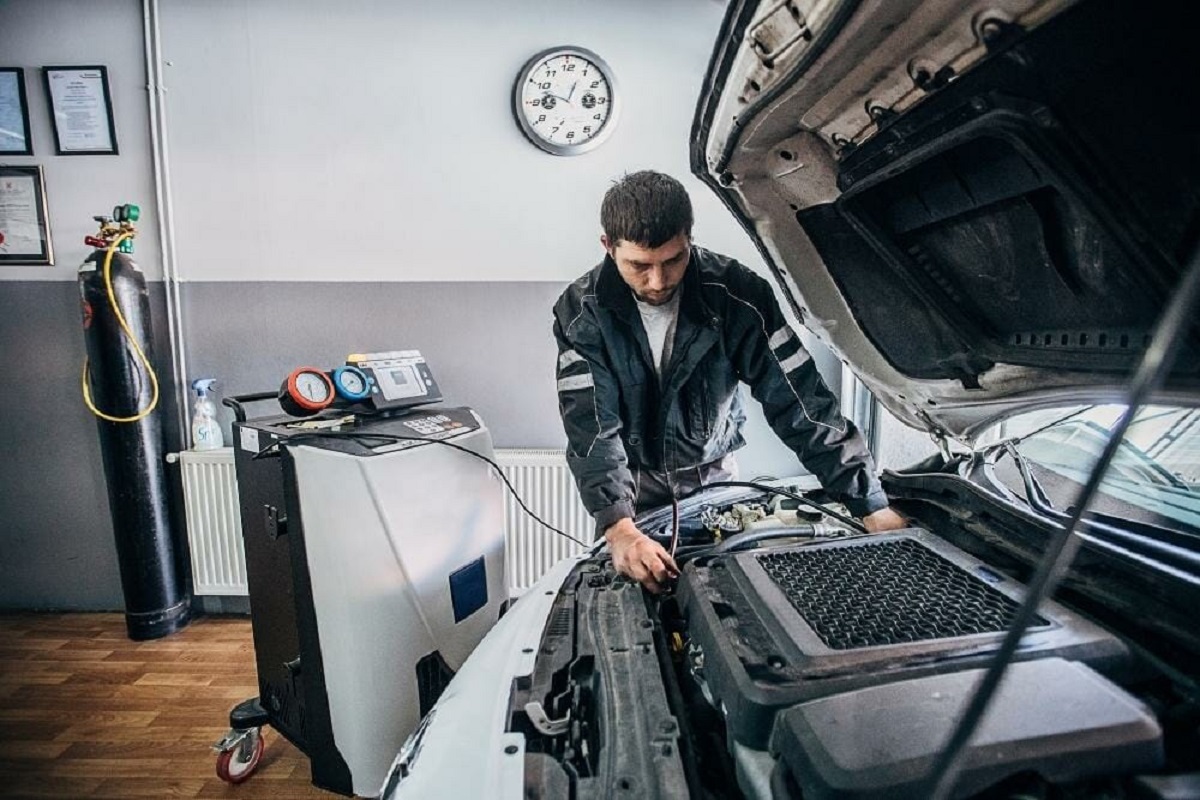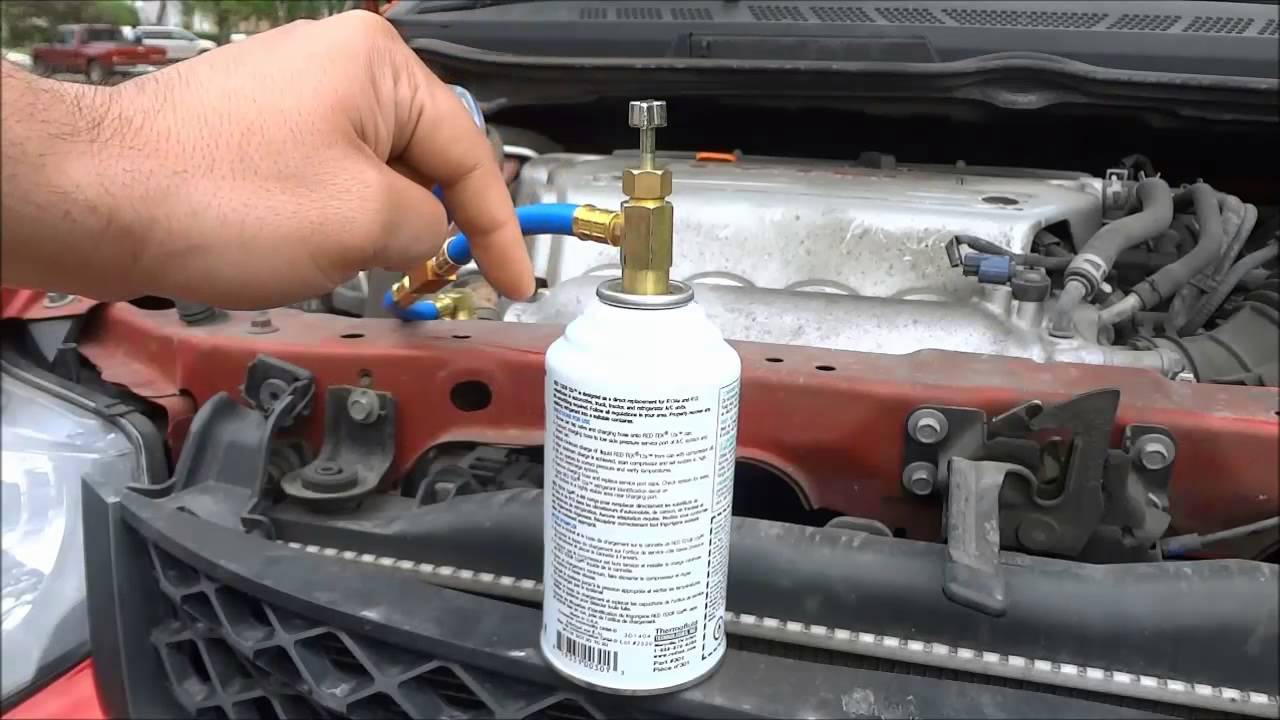

Articles
How To Refill AC In Car
Modified: January 6, 2024
Learn how to refill the AC in your car with our informative articles. Keep your car cool and comfortable all summer long.
(Many of the links in this article redirect to a specific reviewed product. Your purchase of these products through affiliate links helps to generate commission for Storables.com, at no extra cost. Learn more)
Introduction
Welcome to our comprehensive guide on how to refill the AC in your car. As the summer heat starts to intensify, it’s essential to keep your vehicle’s air conditioning system in optimal working condition. A properly functioning AC not only provides a comfortable driving experience but also helps to prevent overheating and fatigue during long journeys.
Understanding the basics of your car’s AC system and knowing when it needs to be refilled can save you time and money. While a professional AC service is typically recommended, refilling the AC yourself can be a cost-effective solution if you have the right tools, materials, and a basic understanding of the process.
In this article, we will walk you through the step-by-step process of refilling the AC in your car. From gathering the necessary tools and materials to identifying the low-pressure port and finally refilling the system, we will provide you with all the information you need to do it safely and effectively.
Before we dive into the details, it’s important to note that working on your car’s AC system requires a certain level of mechanical knowledge and caution. If you are not confident in your abilities or have doubts about the condition of your AC system, it’s best to consult a professional technician.
Now, let’s get started on our journey to understanding how to refill the AC in your car and enjoy a cool and comfortable drive even in the scorching summer heat.
Key Takeaways:
- Understanding the AC system, recognizing signs of low refrigerant, and following proper steps can help you effectively refill the AC in your car, ensuring a comfortable driving experience even in scorching heat.
- Regular maintenance, including checking for leaks, testing the AC system, and following maintenance tips, is crucial for maintaining a properly functioning AC and enjoying consistent cooling comfort in your car.
Read more: How To Test AC Compressor In Car
Understanding the AC System in Your Car
Before you can confidently refill the AC in your car, it’s important to have a basic understanding of how the AC system works. The AC system in your car performs a complex task of cooling the air inside the cabin and removing the excess moisture. It consists of several crucial components that work together to provide you with a comfortable driving experience.
The AC system in your car consists of the following main components:
- Compressor: The compressor is the heart of the AC system. It is responsible for compressing and circulating the refrigerant, which is a chemical compound that absorbs and releases heat.
- Condenser: The condenser is a heat exchanger located at the front of the car’s radiator. It helps to release heat from the refrigerant, converting it from a high-pressure gas to a high-pressure liquid.
- Evaporator: The evaporator is located inside the car’s HVAC (Heating, Ventilation, and Air Conditioning) system. It facilitates the transfer of heat from the air, making it cooler as the refrigerant evaporates.
- Expansion Valve: The expansion valve regulates the flow of refrigerant into the evaporator. It also helps to lower the pressure of the refrigerant, allowing it to evaporate and cool the air passing through the HVAC system.
- Refrigerant: The refrigerant is a chemical compound that absorbs heat from the air and releases it outside the car. It undergoes a continuous cycle of compression, condensation, expansion, and evaporation to create a cooling effect.
Understanding these components and their functions will help you grasp the importance of regular maintenance and the need for refilling the AC system when necessary. Over time, the refrigerant in your AC system may leak or become depleted, resulting in reduced cooling performance. By refilling the AC, you restore the refrigerant to its optimal level, ensuring efficient cooling and extending the life of your AC system.
Next, we will discuss some common signs that indicate your AC system needs to be refilled.
Signs that Your AC Needs to Be Refilled
As a car owner, it’s crucial to recognize the signs that indicate your AC system needs to be refilled. Ignoring these signs can lead to reduced cooling efficiency, discomfort while driving, and potential damage to the AC components. Here are some common signs that your AC needs to be refilled:
- Weak Airflow: If you notice a decrease in the airflow from your AC vents, it could be a sign that your AC refrigerant is low. Insufficient refrigerant can hinder the proper functioning of the AC system and reduce the amount of cool air that is circulated into the cabin.
- Warm Air: When your AC is blowing warm or mildly cool air instead of cold air, it indicates that the refrigerant level is low. The refrigerant is responsible for absorbing heat from the air, and if it is depleted, the cooling effect will be compromised.
- Longer Cooling Time: If you find that it takes longer for your car’s AC system to cool down the cabin, it could be due to a low refrigerant level. Insufficient refrigerant means the AC system has to work harder and longer to achieve the desired temperature.
- Strange Noises: Unusual sounds coming from your AC system could signify a problem with the compressor, which may be caused by low refrigerant. If you hear hissing, bubbling, or grinding noises when the AC is running, it’s advisable to have it checked and potentially refilled.
- Leakage: Spotting any refrigerant leakage under your car or around the AC components is a clear indication that your AC system needs attention. Refrigerant leaks not only reduce cooling performance but can also be harmful to the environment.
If you experience any of these signs, it’s essential to take prompt action to refill your car’s AC system. Refilling the AC will restore the refrigerant to its optimal level, ensuring efficient cooling and a comfortable driving experience.
Now that we have identified the signs that indicate the need for AC refill, let’s move on to preparing for the refill process.
Preparing to Refill the AC
Before you begin the process of refilling the AC in your car, it’s important to make adequate preparations to ensure a smooth and safe operation. Here are some essential steps to follow:
- Gather the Necessary Tools and Materials: To refill the AC, you will need several tools and materials, including a refrigerant canister with the correct type of refrigerant for your car, safety gloves, safety glasses, a pressure gauge, and a car manual for reference. It’s important to use the appropriate refrigerant specified by the car manufacturer to avoid any damage to the AC system.
- Identify the AC Low-Pressure Port: Before you can attach the refrigerant canister, you need to locate the AC low-pressure port in your car. The low-pressure port is typically located on the larger diameter hose of the AC system, near the compressor or the firewall of the car for easy access.
- Inspect the AC System: Take a close look at the AC system for any signs of damage, leaks, or loose connections. It’s crucial to address any issues before refilling the AC to prevent further damage or refrigerant loss.
- Check the Ambient Temperature: It’s important to consider the ambient temperature when refilling the AC. The optimal temperature range for AC refill is typically between 70°F and 90°F. Refilling the AC in extreme temperatures may affect the accuracy of pressure readings and the performance of the system.
- Ensure Proper Ventilation: When refilling the AC, make sure you are working in a well-ventilated area. The refrigerant can release harmful fumes, so it’s important to keep windows and doors open or work in a garage with proper ventilation. Avoid working in confined spaces to prevent the buildup of fumes.
- Take Safety Precautions: Remember to wear safety gloves and glasses throughout the refilling process to protect yourself from refrigerant splashes and potential eye injuries.
By preparing yourself with the necessary tools, identifying the low-pressure port, inspecting the AC system, considering the ambient temperature, ensuring proper ventilation, and taking safety precautions, you are ready to proceed with refilling the AC in your car.
Next, we will discuss in detail how to gather the necessary tools and materials for the refill process.
Gathering the Necessary Tools and Materials
Before you can proceed with refilling the AC in your car, it’s important to gather all the necessary tools and materials. Having the right equipment ensures a smooth and efficient refill process. Here are the essential tools and materials you will need:
- Refrigerant Canister: Choose a refrigerant canister that is compatible with your car’s AC system. Make sure to check the car manual or consult with a professional to determine the appropriate type and amount of refrigerant required.
- Safety Gloves: Wear a pair of gloves to protect your hands from contact with the refrigerant, which can be harmful to the skin.
- Safety Glasses: Wear safety glasses to shield your eyes from any potential splashes or leaks of the refrigerant.
- Pressure Gauge: A pressure gauge is used to monitor the pressure in the AC system. It will help you determine when the system is adequately filled with refrigerant.
- Car Manual: Keep your car manual handy for reference. It provides valuable information on the location of the low-pressure port, the type of refrigerant to use, and the specific instructions for your vehicle model.
- Flashlight: A flashlight can come in handy when inspecting the AC system and locating the low-pressure port, especially in dimly lit areas.
- Rags or Towels: Keep some rags or towels nearby to clean up any spills or leaks that may occur during the refill process.
- Container for Used Refrigerant: Have a container ready to collect any used refrigerant to prevent environmental contamination. Ensure that the container is properly sealed and labeled.
Make sure to gather all the tools and materials listed above before you start the refill process. Having these items readily available will make the process smoother and more efficient.
Once you have gathered all the necessary tools and materials, you can proceed to the next step: locating the AC low-pressure port.
Read more: How To Vacuum A Car AC System
Locating the AC Low-Pressure Port
Locating the AC low-pressure port is an important step in the process of refilling the AC in your car. The low-pressure port is where you will attach the refrigerant canister to inject the refrigerant into the system. Here are the steps to help you locate the AC low-pressure port:
- Refer to your Car Manual: The first step is to consult your car manual to find information on the location of the low-pressure port. The manual will provide specific details and diagrams showing the port’s position in your vehicle.
- Identify the AC Components: Familiarize yourself with the different components of the AC system in your car. Look for the compressor, which is the main part of the system, as the low-pressure port is typically located in close proximity.
- Follow the AC Lines: Trace the AC lines from the compressor towards the firewall or the condenser at the front of the vehicle. The low-pressure port is usually situated on the larger diameter hose of the AC system, making it easier to identify.
- Look for Protective Caps: The low-pressure port is usually covered with a protective cap to prevent dirt and debris from entering. Look for a small, plastic cap that can be easily removed.
- Use a Flashlight: In some cases, the low-pressure port may be tucked away in a tight spot or located in a dimly lit area. Use a flashlight to help you locate and identify the port.
- Verify with Online Resources: If you are having difficulty finding the low-pressure port, you can search for online resources specific to your car’s make and model. Many car forums and websites provide helpful guides and images to assist you.
Remember to take caution when handling AC components and avoid touching any hot surfaces. Once you have located the low-pressure port, make sure to keep it clean and free from debris before proceeding to the next step.
With the low-pressure port located, you are now ready to attach the refrigerant canister and begin refilling the AC system. We will discuss the refill process in detail in the next section.
When refilling the AC in your car, make sure to use the correct type of refrigerant specified in your car’s manual. Overfilling can damage the system, so follow the manufacturer’s guidelines carefully.
Attaching the Refrigerant Canister
Now that you have located the AC low-pressure port, it’s time to attach the refrigerant canister and begin the process of refilling the AC system. Here are the steps to follow when attaching the refrigerant canister:
- Put on Safety Gloves and Glasses: Before handling the refrigerant canister, make sure to wear safety gloves and glasses to protect yourself from potential leaks or splashes.
- Remove the Protective Cap: Locate the low-pressure port and remove the protective cap by twisting it counterclockwise. Set the cap aside in a safe place to avoid losing it.
- Inspect the Port and Canister: Take a moment to inspect the low-pressure port and the refrigerant canister. Ensure that both are clean and free from any debris or damage.
- Shake the Canister: Shake the refrigerant canister gently to mix the contents inside. This will help to ensure a proper flow of refrigerant into the AC system.
- Attach the Hose to the Low-Pressure Port: Take the hose from the refrigerant canister and attach it firmly to the low-pressure port. Push it in until it clicks or locks into place.
- Secure the Connection: Once the hose is attached, ensure that it is securely connected to the low-pressure port to prevent any leaks during the refill process.
- Hold the Canister Upright: Hold the refrigerant canister in an upright position to allow the refrigerant to flow properly. Tilt the canister slightly to allow the refrigerant to enter the AC system gradually.
It’s important to follow the manufacturer’s instructions provided on the refrigerant canister. Some canisters may have additional steps or specific guidelines for attaching the hose and initiating the refill process.
With the refrigerant canister securely attached to the low-pressure port, you are now ready to proceed with the refilling of the AC system. In the next section, we will discuss the steps for refilling the AC and ensuring a proper recharge.
Refilling the AC System
With the refrigerant canister properly attached to the AC low-pressure port, it’s time to refill the AC system and restore its cooling efficiency. Here are the steps to follow for refilling the AC:
- Start the Engine: Start your car’s engine and let it run at idle. Ensure that the AC is turned off during this step.
- Monitor the Pressure Gauge: Keep an eye on the pressure gauge connected to the refrigerant canister. The gauge will provide you with information on the current pressure in the system.
- Open the Valve: Slowly open the valve on the top of the refrigerant canister. This will allow the refrigerant to flow into the AC system.
- Monitor the Refill Process: Observe the pressure gauge and monitor the refill process. As the refrigerant flows into the system, the pressure on the gauge will increase.
- Stop Refilling at Optimal Pressure: Stop refilling the AC system once the pressure gauge reaches the recommended pressure level specified in your car manual. Overfilling can damage the AC system and affect its performance.
- Close the Canister Valve: Once the desired pressure is reached, close the valve on the refrigerant canister to stop the flow of refrigerant.
- Disconnect the Hose: Carefully detach the hose from the low-pressure port. Be cautious to avoid any refrigerant leaks while doing so.
- Replace the Protective Cap: Place the protective cap back on the low-pressure port and securely fasten it by twisting it clockwise. This will help to keep the port clean and protected.
It’s important to note that the refill process should be done gradually and carefully. Take your time to ensure that the refrigerant is being properly transferred into the AC system. If you encounter any difficulties or notice any unusual behavior, it’s advisable to stop and consult a professional mechanic.
After refilling the AC system, it’s necessary to check for leaks and test the functionality of the AC. The next sections will guide you through these important steps to ensure a properly functioning AC system.
Checking for Leaks
After refilling the AC system, it’s crucial to check for any potential leaks. Identifying and addressing leaks is essential to maintain the efficiency and proper functioning of the AC. Here are the steps to follow when checking for leaks:
- Inspect the AC Components: Conduct a visual inspection of the AC components, including the hoses, fittings, and connections. Look for any signs of refrigerant leakage, such as oily residue or stains.
- Use a Leak Detection Kit: Use a leak detection kit, available at auto parts stores, to locate any small leaks that may not be visible to the naked eye. Follow the instructions provided with the kit to effectively detect leaks.
- Listen for Hissing Sounds: While the AC is running, listen for any hissing sounds near the AC components. Hissing sounds can indicate a refrigerant leak, and further investigation is required.
- Check for Frost or Ice: Inspect the AC components for any frost or ice formation. Excessive frost or ice can suggest a refrigerant leak or an issue with the system’s performance.
- Use Soapy Water: Apply a thin layer of soapy water to the AC components and connections. If you notice any bubbles forming, it indicates the presence of a leak. Take note of the location of the bubbles and address the issue accordingly.
If you identify any leaks during the inspection process, it’s important to address them promptly. Leaks not only reduce the efficiency of the AC system but can also lead to further damage and refrigerant loss. Consider seeking assistance from a professional technician to repair any leaks and ensure the proper functioning of the AC system.
Once you have thoroughly checked for leaks and made any necessary repairs, you can proceed to the final step: testing the AC system.
Read more: How To Check AC Pressure In Car
Testing the AC System
After refilling the AC system and checking for leaks, it’s important to test the AC system to ensure it is functioning properly. Testing the system will help you determine if the refrigerant refill has been successful and if the AC is providing the desired cooling performance. Here are the steps to follow when testing the AC system:
- Close all Windows and Doors: Before testing the AC, make sure all windows and doors of the vehicle are closed. This will allow you to evaluate the cooling efficiency accurately.
- Turn on the Engine: Start the engine and let it run at idle. The AC system needs the engine to be running for it to operate effectively.
- Set the AC to Max Cooling: Adjust the AC controls to the maximum cooling setting. This will activate the compressor and allow the system to achieve its optimal cooling capacity.
- Listen and Observe: Pay attention to the sounds and airflow coming from the AC vents. Check if the air blowing out is cool and sufficient in volume. Listen for any unusual noises that may indicate a problem with the AC system.
- Monitor the Temperature: Use a thermometer to measure the temperature of the air coming out of the AC vents. It should be significantly cooler than the ambient temperature. If the air is not cold enough or if there is no noticeable difference in temperature, further investigation may be required.
- Ensure Proper Airflow: Verify that the AC vents are delivering the air in the correct direction and with adequate force. Adjust the vents as needed to achieve the desired airflow.
- Test Different Controls: Experiment with different temperature settings, fan speeds, and vent modes to ensure all aspects of the AC system are functioning correctly. Pay attention to any changes or inconsistencies in performance.
If you notice any issues during the testing process, such as inadequate cooling, strange odors, or abnormal sounds, it’s best to consult a professional for a thorough inspection and potential repairs. A technician will have the expertise and equipment to diagnose and resolve any underlying problems with the AC system.
By testing the AC system after refilling and checking for leaks, you can confirm that the system is functioning optimally and providing the desired cooling comfort for your car.
Now that you have successfully refilled and tested the AC system, it’s important to keep a few tips in mind for maintaining a properly functioning AC system, which we will discuss in the next section.
Tips for Maintaining a Properly Functioning AC
Now that you have refilled and tested your car’s AC system, it’s essential to maintain it properly to ensure consistent and efficient cooling performance. Here are some tips to help you keep your AC in top condition:
- Regular Maintenance: Schedule regular maintenance inspections for your AC system. Professional technicians can check for any issues, perform necessary repairs, and ensure the system is running optimally.
- Replace Cabin Air Filter: Regularly replace the cabin air filter in your car. A clean filter prevents dust and debris from clogging the AC system, improving its performance and air quality.
- Run the AC Regularly: Even during the colder months, it’s recommended to run the AC for a few minutes every week to keep the system lubricated and prevent seals from drying out.
- Keep AC Vents Clear: Ensure that the AC vents are not blocked by objects such as papers, clothes, or other items. Clear vents promote proper airflow and help maintain consistent cooling throughout the cabin.
- Avoid Extreme Temperature Changes: Try to avoid drastic temperature changes in your car. Rapidly changing the temperature setting from hot to cold or vice versa can put stress on the AC system.
- Reduce Heat in the Cabin: Park your car in shaded areas or use sunshades to reduce heat buildup inside the cabin. This can help lessen the load on the AC system, improving its performance.
- Address Unusual Smells or Sounds: If you notice any strange odors or unusual sounds coming from your AC system, have it inspected by a professional technician. Unusual smells or sounds could indicate a problem that needs immediate attention.
- Monitor Refrigerant Levels: Regularly check the refrigerant levels in your AC system. If you notice a decrease in cooling performance or signs of a leak, it may indicate a need for refilling or repairs.
- Follow Manufacturer’s Guidelines: Always refer to the car’s manual and follow the manufacturer’s guidelines when it comes to AC maintenance, including type and amount of refrigerant, recommended service intervals, and specific instructions for your vehicle model.
By following these maintenance tips, you can extend the lifespan of your AC system and ensure it continues to provide efficient cooling, contributing to a comfortable driving experience.
Congratulations! You have learned how to refill the AC in your car and maintain it properly. By taking the time to understand and care for your AC system, you can enjoy cool and comfortable rides all year round.
If you have any further questions or concerns about your car’s AC system, it’s always best to consult a professional technician for expert advice and assistance.
Conclusion
Properly maintaining and refilling the AC in your car is essential for a comfortable driving experience, especially during the hot summer months. By understanding the basics of your car’s AC system, recognizing signs of low refrigerant, and following the necessary steps, you can refill the AC system effectively and restore its cooling efficiency.
In this comprehensive guide, we have covered the importance of understanding the AC system in your car, signs indicating the need for a refill, and the steps to prepare for the refill process. We also discussed how to gather the necessary tools and materials, locate the AC low-pressure port, attach the refrigerant canister, and successfully refill the AC system. Additionally, we highlighted the significance of checking for leaks, testing the AC system, and provided tips for maintaining a properly functioning AC.
Remember, while refilling the AC yourself can be a cost-effective solution, it’s always recommended to consult a professional technician if you are unsure or encounter any difficulties during the process. They have the expertise and knowledge to handle any potential issues and ensure the AC system is operating at its best.
By following the guidelines provided in this article and practicing regular AC maintenance, you can enjoy a consistently cool and comfortable driving experience in your car. Take care of your AC system, and it will continue to keep you refreshed, no matter how scorching the weather outside.
Thank you for reading our guide on how to refill the AC in your car. Stay cool and safe on the roads!
Frequently Asked Questions about How To Refill AC In Car
Was this page helpful?
At Storables.com, we guarantee accurate and reliable information. Our content, validated by Expert Board Contributors, is crafted following stringent Editorial Policies. We're committed to providing you with well-researched, expert-backed insights for all your informational needs.














0 thoughts on “How To Refill AC In Car”